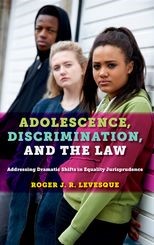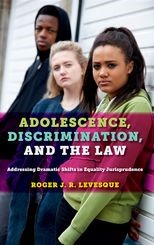Adolescence, Discrimination, and the Law: Addressing Dramatic Shifts in Equality Jurisprudence
Adolescence, Discrimination, and the Law: Addressing Dramatic Shifts in Equality Jurisprudence
Cite
Abstract
In the wake of the civil rights movement, the legal system dramatically changed its response to discrimination based on race, gender, and other characteristics. It is now showing signs of yet another dramatic shift, as it moves from considering difference to focusing on neutrality. Rather than seeking to counter subjugation through special protections for groups that have been historically (and currently) disadvantaged, the Court now adopts a “colorblind” approach. Equality now means treating everyone the same way. This book explores these shifts and the research used to support civil rights claims, particularly relating to minority youths' rights to equal treatment. It integrates developmental theory with work on legal equality and discrimination, showing both how the legal system can benefit from new research on development and how the legal system itself can work to address invidious discrimination given its significant influence on adolescents—especially those who are racial minorities—at a key stage in their developmental life. The book articulates the need to address discrimination by recognizing and enlisting the law's inculcative powers in multiple sites subject to legal regulation, ranging from families, schools, health and justice systems to religious and community groups. The legal system may champion ideals of neutrality in the goals it sets itself for treating individuals, but it cannot remain neutral in the values it supports and imparts. The book shows that despite the shift to a focus on neutrality, the Court can and should effectively foster values supporting equality, especially among youth.
-
Front Matter
-
Introduction
Roger J. R. Levesque
-
1
Shifts in Equality Jurisprudence
Roger J. R. Levesque
-
2
The Nature, Developmental Roots, and Alleviation of Discrimination
Roger J. R. Levesque
-
3
Addressing Necessary Shifts in Equality Jurisprudence
Roger J. R. Levesque
-
4
Supporting Equality Jurisprudence’s Sites of Inculcation
Roger J. R. Levesque
-
5
Harnessing Developmental Science to Broaden Equality Jurisprudence
Roger J. R. Levesque
-
Conclusion
Roger J. R. Levesque
-
End Matter
Sign in
Personal account
- Sign in with email/username & password
- Get email alerts
- Save searches
- Purchase content
- Activate your purchase/trial code
Institutional access
-
Sign in through your institution
- Sign in with a library card Sign in with username/password Recommend to your librarian
Institutional account management
Sign in as administratorPurchase
Our books are available by subscription or purchase to libraries and institutions.
Purchasing information| Month: | Total Views: |
|---|---|
| June 2023 | 1 |
| October 2023 | 1 |
| March 2024 | 2 |




Get help with access
Institutional access
Access to content on Oxford Academic is often provided through institutional subscriptions and purchases. If you are a member of an institution with an active account, you may be able to access content in one of the following ways:
IP based access
Typically, access is provided across an institutional network to a range of IP addresses. This authentication occurs automatically, and it is not possible to sign out of an IP authenticated account.
Sign in through your institution
Choose this option to get remote access when outside your institution. Shibboleth/Open Athens technology is used to provide single sign-on between your institution’s website and Oxford Academic.
If your institution is not listed or you cannot sign in to your institution’s website, please contact your librarian or administrator.
Sign in with a library card
Enter your library card number to sign in. If you cannot sign in, please contact your librarian.
Society Members
Society member access to a journal is achieved in one of the following ways:
Sign in through society site
Many societies offer single sign-on between the society website and Oxford Academic. If you see ‘Sign in through society site’ in the sign in pane within a journal:
If you do not have a society account or have forgotten your username or password, please contact your society.
Sign in using a personal account
Some societies use Oxford Academic personal accounts to provide access to their members. See below.
Personal account
A personal account can be used to get email alerts, save searches, purchase content, and activate subscriptions.
Some societies use Oxford Academic personal accounts to provide access to their members.
Viewing your signed in accounts
Click the account icon in the top right to:
Signed in but can't access content
Oxford Academic is home to a wide variety of products. The institutional subscription may not cover the content that you are trying to access. If you believe you should have access to that content, please contact your librarian.
Institutional account management
For librarians and administrators, your personal account also provides access to institutional account management. Here you will find options to view and activate subscriptions, manage institutional settings and access options, access usage statistics, and more.